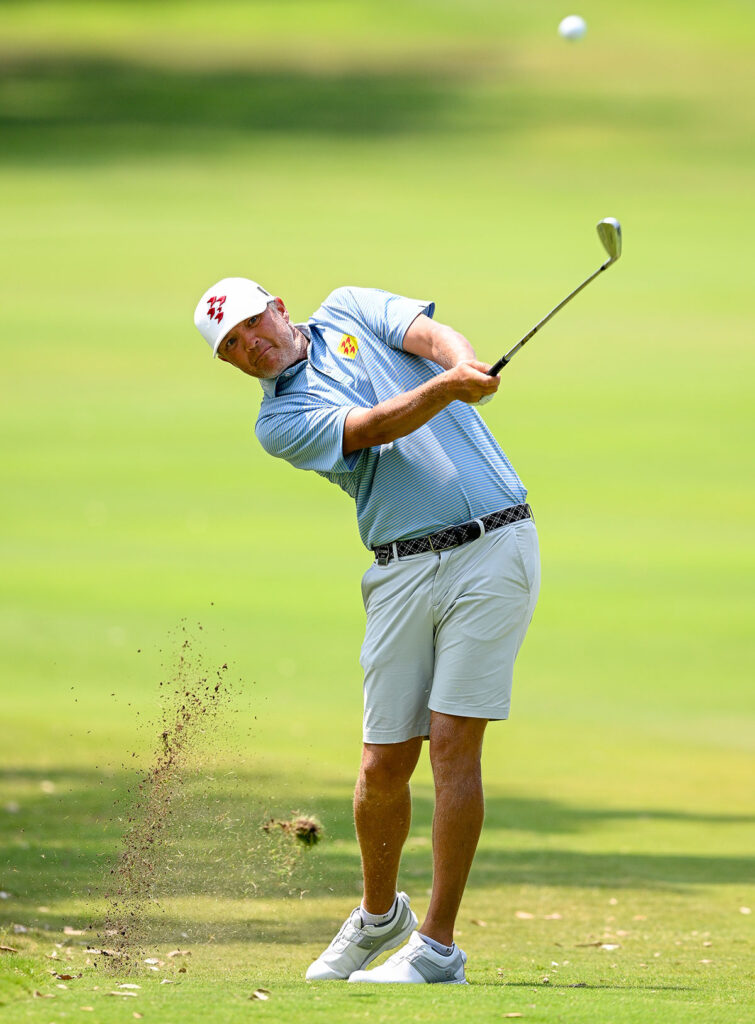Matt Jones puts in the hours on the range and in the gym so that he takes only seconds over the ball. Here’s what you can learn from a pro who has won two Australian Opens, two PGA Tour events and is now a key part of Cam Smith’s LIV Golf team, Ripper GC.
People think I’m the fastest player in the world. That’s not exactly true. I’m a fast player, but I don’t think I’m as fast as people make me out to be. The cameras on tour only show me over the ball, not behind it. Back there is where I take several practice swings and rehearse my positions. In those moments, I’m getting the feeling I want to emulate in the full swing: I’m practising the shot shape, the position I want at impact and how high or low I want to hit it. Then, I just walk in and hit that shot. This process keeps me moving and keeps me athletic. Basically, I’m rehearsing the feeling and hitting the ball while the feeling is still fresh in my mind.
I’ve always wanted motion in my golf swing. I’ve always wanted to feel like I’m moving right up until I pull the club back. I don’t enjoy feeling like I’m stuck when I’m standing over the ball. Some of that comes from me and some of it from my long-time coach, Gary Barter, and the work we have done since I was a younger lad at The Australian Golf Club. He’s always encouraged motion, athleticism and being ready to perform the swing. I pretend I’m ready take off in my runner’s stance. I’m ready to push off both feet.

Step into it like a home-run hitter
Lee Trevino was one of the best at being dynamic. Golfers are trying to create speed from a from a stationary position; you initiate the golf swing – rather than reacting – and the ball is not coming at you with any velocity. You’ve got to create the speed yourself. So why not move into the ball? I like to picture a baseball player, stepping into the pitch when it comes at them. Sometimes, you’ll see me make a practice swing, step closer to the ball, make another practice swing, then take my stance and hit. I’m trying to create a feeling that the ball is coming at me and I’m stepping in to slug it.

My most common swing thought
I like to have a steeper shoulder plane from transition into the ball. I try to feel that my right side is staying high. Anytime my right side gets low, my hips shift towards the target and then my right leg will shift towards the target. I can start to hit fat shots and blocked shots and can’t control my shot shape or trajectory. During the swing, I like to keep my right side – mainly my right hip – high for as long as I can down into the ball. On the reverse side, once I’ve made impact, I try to feel that my left side is getting nice and high on the way through.
The No.1 mistake amateurs make
I see a lot of golfers trying to help the ball up into the air. They hang back and try and hit up on it. But the golf club is designed to help you get the ball in the air, so hit down on the ball. Take a short, deep divot and let the club and the loft do the work for you. Never be afraid to take a divot.

Don’t overestimate your distances
Many amateurs, at least in the pro-ams I play, think they hit it a lot further than they do. The truth is your 7-iron doesn’t fly as far as a 7-iron for a professional. But that’s OK; we are athletes who train every day. As an amateur, really learn your average distance for each club and work from there. Take an extra club on approach shots; it will encourage you to swing smoother and having better timing. You’ll also learn which club to hit to ensure a mis-hit lands on the front of the green, a flushed shot carries towards the middle or back of the green and your average strike finishes somewhere near the hole. That way, you’ll start hitting more greens.



